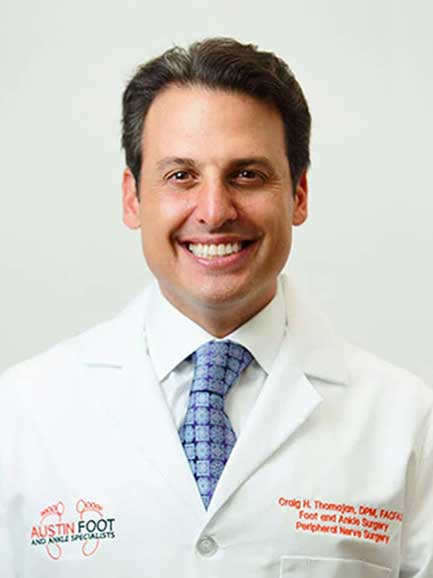
You've suffered with that painful bunion for months or maybe even years. Conservative treatments like wider shoes, padding, and custom orthotics haven't provided adequate relief. Now your Austin podiatrist is recommending surgery. But what will the procedure involve, and how long will recovery take?
Bunion surgery has progressed significantly in recent decades. While the primary goal is still to relieve pain and restore normal foot function, today's techniques are more advanced than ever. As an Austin podiatry practice on the cutting edge of foot and ankle care, Austin Foot and Ankle Specialists is proud to offer the revolutionary Lapiplasty procedure for bunion correction. This treatment is a prime example of how far bunion surgery has come.
The Traditional Approach to Bunion Surgery
For many years, the go-to bunion surgery was an osteotomy procedure. This involved cutting the metatarsal bone near the bunion, rotating the bone, and fixing it in place with pins, wires, or screws.
Several types of osteotomy procedures have been used to treat bunions over the years:
- Distal Chevron osteotomy. This technique involves making a V-shaped cut at the head of the first metatarsal bone to shift the bone back into proper alignment. It's often used for mild to moderate bunions.
- Scarf osteotomy. With this method, the surgeon makes a Z-shaped cut along the first metatarsal shaft, allowing them to rotate and realign the bone. Scarf osteotomies provide more stability than distal osteotomies.
- Proximal osteotomy. For more severe bunions, cuts may be made at the base of the metatarsal bone to achieve a greater degree of correction. Proximal osteotomies are more complex and require longer healing times.
- Akin osteotomy. This procedure involves cutting and realigning the first phalanx (big toe bone) to further straighten the joint. It's often performed in combination with metatarsal osteotomies.
In some cases, the surgeon may also need to reposition the surrounding ligaments and tendons to fully correct the bunion deformity and restore proper joint alignment.
While osteotomy procedures can be effective for relieving bunion symptoms, they have several drawbacks:
- Long recovery times. It typically takes six weeks or longer before patients can bear weight on the foot after a traditional bunion surgery. Full recovery may take four to six months.
- Extended downtime. Most patients need to take a significant amount of time off work to recover, especially if their job requires standing or walking for long periods. Crutches, a knee scooter, or other mobility aids are usually necessary.
- Recurrence risk. Because traditional osteotomy techniques don't always address the root cause of the bunion at the midfoot joint, there's a risk the deformity will return over time.
- Postoperative stiffness. Cutting and repositioning the bones can lead to joint stiffness and reduced range of motion, even after the initial healing period. Physical therapy is often necessary to restore full function.
- Prolonged swelling. It's common for post-operative swelling to persist for several months after traditional bunion surgery, which can be uncomfortable and affect the fit of shoes.
Despite these limitations, traditional bunion surgery has long been considered the best treatment option for patients with intractable bunion pain— until now. Lapiplasty 3D bunion correction has revolutionized how foot and ankle specialists approach bunion surgery, offering key advantages over conventional techniques.
The Evolution From Traditional Bunion Surgery to Lapiplasty
Over the years, foot and ankle surgeons recognized the shortcomings of traditional osteotomy procedures for bunion correction. While these techniques could improve the cosmetic appearance of the foot, they didn't always address the underlying biomechanical cause of bunions—an unstable joint at the base of the big toe called the first tarsometatarsal (TMT) joint.
Seeking a better solution, surgeons began to study the complex three-dimensional anatomy of the bunion deformity. Advanced imaging techniques revealed that bunions have three main components:
- An enlarged metatarsal head that protrudes outward
- Rotation of the first metatarsal bone
- Sideways tilting of the first metatarsal bone
Traditional osteotomy procedures mainly addressed the first component by cutting and realigning the metatarsal head. But without correcting the rotation and tilting of the metatarsal bone at the foundational TMT joint, results were often temporary.
Lapiplasty for bunion correction was developed as a comprehensive solution to fix all three dimensions of the bunion deformity at the root cause. Using precision surgical instruments and advanced imaging, surgeons can now correct the bunion in all three anatomical planes, stabilizing the TMT joint with patented titanium plating technology.
This innovative approach offers several advantages over traditional bunion surgery:
- Addresses the root cause. By correcting the unstable TMT joint, Lapiplasty realigns the entire metatarsal bone in three dimensions, straightening the big toe joint at the source of the problem.
- Reduces recurrence risk. Permanently stabilizing the TMT joint helps prevent the metatarsal bone from drifting back out of position over time, lowering the risk of bunion recurrence.
- Faster recovery. The Lapiplasty system uses two low-profile titanium plates to secure the surgical correction, allowing patients to bear weight on their feet within days instead of weeks. Return to work and activities often happens sooner.
- More consistent results. Lapiplasty's meticulous measurement and precision realignment help ensure optimal 3D bunion correction with every procedure. Surgeons can finally address all components of the deformity in a reproducible way.
Lapiplasty is a significant step forward in the evolution of bunion surgery. By building upon the lessons learned from decades of traditional bunion procedures and leveraging advanced surgical technologies, this novel technique offers new hope for lasting relief from bunion symptoms.
Who Is a Candidate for Lapiplasty?
While Lapiplasty has many benefits, it may not be right for everyone. The best candidates are generally healthy adults with moderate to severe bunion foot pain that interferes with daily activities.
Certain factors might rule out Lapiplasty, such as:
- Very small or flexible bunions. These deformities may be adequately treated with traditional bunion surgery techniques.
- Extremely large or arthritic bunions. In some cases, the joint damage and deformity may be too severe for Lapiplasty to be effective.
- Health conditions. Uncontrolled diabetes, circulatory issues, or autoimmune diseases could impair healing after any foot surgery.
The only way to know for sure if you're a candidate for Lapiplasty is to see a foot and ankle specialist. They can fully evaluate your bunion, overall health, and lifestyle factors to determine the best path forward.
Lapiplasty Expertise in Austin, TX
As an innovative Austin podiatry practice, Austin Foot and Ankle Specialists is proud to be at the forefront of advanced bunion treatments like Lapiplasty. Our podiatrists are highly trained in this specialized 3D bunion correction technique.
Board-certified in foot surgery and reconstructive ankle/rearfoot surgery, Dr. Craig Thomajan has the expertise to handle even the most complex bunion cases. He and his team take the time to educate each patient about their treatment options, ensuring they feel informed and confident in their care plan.
If you're struggling with bunion pain, don't settle for living with limitations. With our cutting-edge approach and commitment to exemplary care, you can get back to enjoying life with healthy, pain-free feet.

